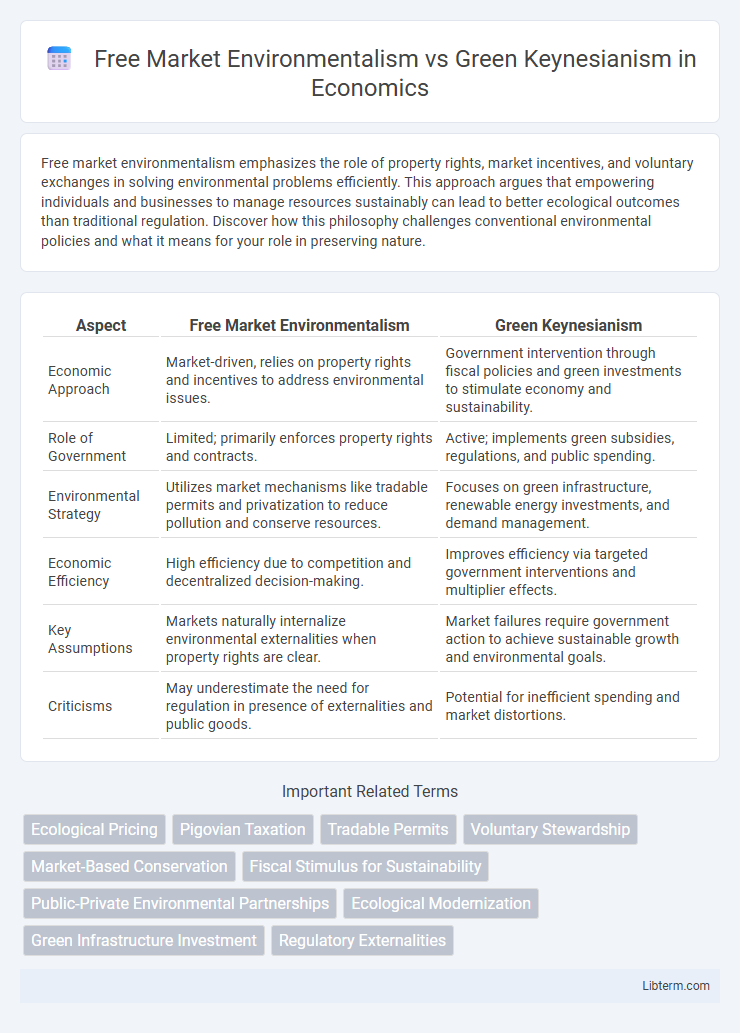Free market environmentalism emphasizes the role of property rights, market incentives, and voluntary exchanges in solving environmental problems efficiently. This approach argues that empowering individuals and businesses to manage resources sustainably can lead to better ecological outcomes than traditional regulation. Discover how this philosophy challenges conventional environmental policies and what it means for your role in preserving nature.
Table of Comparison
| Aspect | Free Market Environmentalism | Green Keynesianism |
|---|---|---|
| Economic Approach | Market-driven, relies on property rights and incentives to address environmental issues. | Government intervention through fiscal policies and green investments to stimulate economy and sustainability. |
| Role of Government | Limited; primarily enforces property rights and contracts. | Active; implements green subsidies, regulations, and public spending. |
| Environmental Strategy | Utilizes market mechanisms like tradable permits and privatization to reduce pollution and conserve resources. | Focuses on green infrastructure, renewable energy investments, and demand management. |
| Economic Efficiency | High efficiency due to competition and decentralized decision-making. | Improves efficiency via targeted government interventions and multiplier effects. |
| Key Assumptions | Markets naturally internalize environmental externalities when property rights are clear. | Market failures require government action to achieve sustainable growth and environmental goals. |
| Criticisms | May underestimate the need for regulation in presence of externalities and public goods. | Potential for inefficient spending and market distortions. |
Introduction to Free Market Environmentalism and Green Keynesianism
Free Market Environmentalism emphasizes property rights, market incentives, and decentralized decision-making to address environmental challenges efficiently. Green Keynesianism advocates for government intervention and public investments to stimulate green technologies and sustainable economic growth. Both approaches seek environmental protection but differ fundamentally in their reliance on market mechanisms versus state-led policies.
Core Principles of Free Market Environmentalism
Free Market Environmentalism emphasizes property rights, market incentives, and decentralized decision-making as essential tools for addressing environmental issues, advocating that well-defined property rights lead to better resource management and pollution control. This approach relies on voluntary exchanges and competition, promoting innovation and cost-effective solutions without heavy government intervention. By internalizing environmental externalities through market mechanisms, Free Market Environmentalism aims to align economic incentives with ecological sustainability.
Foundations of Green Keynesianism
Green Keynesianism is grounded in the belief that government intervention through fiscal policies and public investment is essential to drive sustainable economic growth and environmental protection simultaneously. It emphasizes the role of green stimulus packages, renewable energy subsidies, and regulatory frameworks to correct market failures and promote low-carbon technologies. The approach also integrates traditional Keynesian demand management with ecological sustainability goals to balance economic stability and environmental preservation.
Policy Mechanisms: Market Solutions vs Government Intervention
Free Market Environmentalism advocates for market-based policy mechanisms such as tradable pollution permits, property rights, and decentralized decision-making to efficiently allocate environmental resources without heavy government interference. Green Keynesianism supports government intervention through fiscal stimulus, green infrastructure investment, and regulatory frameworks to drive sustainable economic growth and address environmental externalities. Market solutions emphasize economic incentives and private sector innovation, while government intervention prioritizes coordinated public spending and regulatory oversight to achieve environmental objectives.
Economic Incentives and Environmental Stewardship
Free Market Environmentalism emphasizes economic incentives through property rights and market mechanisms to promote environmental stewardship by aligning individual profit motives with natural resource conservation. Green Keynesianism advocates for government intervention and public investments in green technologies, using fiscal and monetary policies to drive sustainable economic growth and environmental protection. Both approaches recognize the role of economic incentives, but Free Market Environmentalism relies on decentralized market signals, while Green Keynesianism depends on coordinated policy action to achieve ecological outcomes.
Addressing Climate Change: Contrasting Approaches
Free Market Environmentalism relies on property rights and market incentives to reduce carbon emissions by encouraging innovation and voluntary conservation efforts. Green Keynesianism advocates for active government intervention through fiscal policies and public investment in clean energy infrastructure to drive a low-carbon transition. Each approach shapes climate change strategies differently, emphasizing market-driven solutions versus state-led economic planning.
Role of Innovation and Technology in Sustainability
Free Market Environmentalism emphasizes that innovation and technology thrive best under minimal government intervention, arguing that market-driven solutions lead to efficient, cost-effective sustainability advances. Green Keynesianism supports active government investment and regulation to direct innovation towards sustainable technologies, ensuring broad social and environmental goals are met. Both approaches recognize technology as essential for sustainability, differing primarily in the mechanisms that foster and scale innovative environmental solutions.
Case Studies: Successes and Failures in Practice
Free Market Environmentalism demonstrates effective outcomes in cases like the Texas emissions trading program, which incentivized pollution reduction through market mechanisms, yet struggles in addressing public goods like biodiversity preservation. Green Keynesianism, exemplified by Germany's Energiewende policy, successfully accelerated renewable energy deployment through government investment but faced challenges such as high costs and energy price volatility. Both approaches reveal that hybrid models may better balance efficiency and equity in environmental policy implementation.
Criticisms and Challenges of Each Approach
Free Market Environmentalism faces criticism for relying heavily on property rights and market incentives, which critics argue may fail to address public goods and externalities inherent in environmental issues, leading to under-protection of ecosystems. Green Keynesianism is challenged by concerns over government intervention efficiency, potential crowding out of private investment, and the risk of inflating public debt without guaranteeing effective environmental outcomes. Both approaches must navigate the complexities of balancing economic growth with sustainable environmental stewardship amid evolving global climate policies.
Future Prospects: Bridging the Gap Between Competing Models
Free Market Environmentalism leverages property rights and market incentives to drive sustainable resource management, offering scalable solutions that emphasize innovation and efficiency. Green Keynesianism advocates for increased government intervention and public investment in green technologies to stimulate economic growth while addressing environmental challenges. Bridging these models involves integrating market mechanisms with strategic policy frameworks, fostering collaboration between private sectors and governments to achieve long-term ecological and economic resilience.
Free Market Environmentalism Infographic

 libterm.com
libterm.com